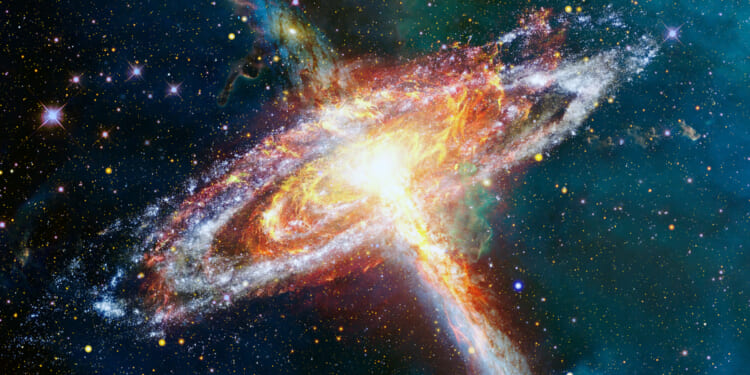In the beginning God created the heaven and the earth. And the earth was without form, and void; and darkness was upon the face of the deep. And the Spirit of God moved upon the face of the waters. And God said, Let there be light: and there was light. And God saw the light, that it was good: and God divided the light from the darkness. —Genesis 1:1–4
______________________________________________________
Pretty much ever since, physicists, too, have been divided about how the universe began—and what happened before it began.
In 1927, Belgian Catholic priest and theoretical physicist Georges Lemaître drew upon Albert Einstein’s theory of general relativity to hypothesize a universe that began with a single point, a so-called “primordial atom,” before expanding to its present size. Two years later, American astronomer Edwin Hubble lent further support to this hypothesis when he observed that distant galaxies were rapidly receding from Earth in nearly all directions.
Fast-forward three decades, and in 1965 Bell Labs scientists Arno Penzias and Robert Wilson discovered cosmic microwave background (CMB) radiation, the predicted “afterglow” of energy remaining from the initial Big Bang, further cementing Lemaître’s hypothesis into what we now call the Big Bang Theory.
Penzias and Wilson were later awarded the Nobel Prize in Physics for their discovery.
How did this all work? Combine evidence of a long-ago explosion with evidence of a universe that’s now expanding, and it didn’t take scientists long to figure they could rewind the cosmic VCR tape to see how things must have gotten started. Reverse the expansion and all of time and space shrinks back to a cosmic pinprick that exploded into existence 13.8 billion years ago. Importantly, nothing lay on the other side of that pinprick. Nothing existed before it, because there was no “before,” before time began.
And so the theory was proved: The universe is not infinite and eternal (as scientists had previously presumed). Both time and space had a beginning and, for lack of a better title, that beginning was the Big Bang.
Or was it?
In Battle of the Big Bang: The New Tales of Our Cosmic Origins, University of Waterloo (Canada) physics and astronomy professor Niayesh Afshordi and (British) Royal Astronomical Society member Phil Halper lay out a series of alternative hypotheses that aim to disrupt “what the public understands as the Big Bang” theory (which the authors deride alternately as a “creation myth” and a “bedtime story”) and to replace it with something … else.
Picture a classic ice cream cone—big gob of ice cream on one end, narrowing down to a point on the other. Up until recently, explain the authors, that’s how scientists generally agreed a timeline of the universe’s lifespan might look in picture form. Everything you see up in the sky today is the ice cream, and the Big Bang sits down there at the tip of the cone, in the form of an infinitely dense singularity. There are, however, a few problems with this theory—questions that no one’s been able to answer yet—and it’s for this reason that Afshordi and Halper assert that “almost no cosmologists believe in the singularity” anymore.
(In the book, it’s not always 100% clear which author is speaking, so from this point on I’ll simply refer to them collectively as “the authors”).
What are these objections? For one, the “ice cream” we see today looks a bit too uniform in both temperature and density in every direction to be easily explained. (Cosmologists call this the “horizon” problem.) At the same time, the authors complain that the ice cream’s not completely uniform, possessing imperfections, regions where the CMB is slightly warmer or cooler than average, as well as places where matter was able to clump together to form galaxies, solar systems, and even our own Earth.
As a non-science-major reader, these objections sound contradictory to me, and the authors aren’t crystal clear on why they’re a huge problem—but clearly, they bug astrophysicists to no end!
Moreover, the universe’s geometry seems “flat,” in the sense that it’s neither “spherical” nor “saddle shaped.” A spherical universe, the authors explain, should collapse back to its original pinpoint, whereas a saddle-shaped universe would stretch out to a point of infinite sparsity. Our universe, in contrast, seems almost perfectly flat such that it can expand forever while maintaining a certain level of density.
Again, the unlikeliness of such flatness happening by accident and the level of fine-tuning that would be required to make this happen disturbs scientists greatly. Enough so, in fact, that they’ve come up with quite a number of hypotheses to explain why the Big Bang Theory, as most non-science people now understand it, probably isn’t the correct way of understanding the universe at all.
In the process, they’ve not only undermined the God hypothesis—a presumed happy side effect of the authors’ expressed antipathy toward “creation myths.” They’ve also revived the ancient idea that the universe may not have had a beginning at all and may instead be infinite in both time and space.
So what are these hypotheses? The authors spend the bulk of the book laying out and explaining a whole laundry list of ideas, along with biographical details of the scientists proposing them—many of whom are known to the authors personally.
Perhaps the best known (to non-scientists) of these hypotheses is string theory, which posits that familiar particles such as protons and electrons that we all learned about in high school science class are actually just manifestations of quantum strings vibrating at different frequencies. String theory in turn has its own new manifestations, including one in which one-dimensional strings are replaced by higher (two or more) dimensional “branes,” and another in which strings can be gases, leading to such convoluted concepts as a “quasi-static oven of thermal strings” that cool down when compressed.
If concepts like that makes your brain hurt, don’t be upset. The authors themselves complain that certain academic papers describing string gas theory take the form of “a series of conjectures in one paper, with a promise to prove them in the next.”
(A promise that, it almost goes without saying, never quite delivers).
Not to be discouraged, the authors plunge ahead to list multiple hypotheses even stranger to behold: “branes” that collide to form universes (although where the branes came from before there was a universe to hold them isn’t clear). Quantum loops to replace cosmic strings (because strings themselves were perhaps too simple a concept) to make up the fabric of space-time. Cyclical universes that expand and shrink eternally. A universe that’s just the visible two-dimensional depiction of the inside of a black hole. A “multiverse” in which universes bubble up continually. “Quantum” particles that pop into existence, then “inflate” to become entire universes.
(At this point one feels compelled to quote Ant-Man: “Do you guys just put the word quantum in front of everything?”)
No idea is too crazy, too novel, or too difficult to prove experimentally to be undeserving of mention, up to and including the idea of changing the (generally agreed to be immutable) speed of light itself. All this to avoid the conclusion that our universe had a beginning, and that there might have been a time when time was not—nor space, either.
Curiously, all the hypotheses the authors describe share the common element of disputing that the universe had a truly Big Bang moment—a “time” when time and space began to exist and when some cause caused the effect that we call our universe today.
What’s really interesting, though, is that each of these supposed improvements upon the original Big Bang Theory also attempt to return cosmology to an earlier view of the universe: While opinions differed as to whether the universe remained static or was cyclical, undergoing periods of death and rebirth, ancient philosophers from India to Persia to Greece generally all agreed that the universe had always existed.
It was only “as Greek civilization eventually went into decline and Christianity began to dominate the Western world,” explain the authors, that the new cosmology of “creation ex nihilo” took hold. Some believed this universe was created “static” and “eternally old.” It took another 2,000 years or so for science (in the form of Einstein, Lemaître, Hubble, Penzias, and Wilson) to conclude otherwise: that the universe began young and has been growing ever since.
Whether this new gaggle of cosmological hypotheses will undo that work and reveal a newer, truer nature of the universe remains to be seen, and will depend largely on whether they can be proved by making testable predictions that pan out —as they largely have not been. In the meantime, caution the authors, “we must be wary of … misplaced confidence,” because while “certainty is seductive … it is not appropriate at the frontiers of science.”
As a lay reader of the book, I admit I found this a bit disappointing. Inappropriate or not, when I open up a science book, I expect to find the scientists providing some clear answers. And in their absence, I was mostly left wondering why anyone would esteem these new ideas of what came before the Big Bang as better than the Big Bang Theory they seek to replace.
Don’t expect the scientists proposing the ideas, however, to easily concede that their hypotheses might not really be any better than Big Bang Classic. As the authors of Battle of the Big Bang quip, whether their ideas work out or not: “Cosmologists are often wrong, but never in doubt.”




![Hegseth Demands Fitness Requirements, Says 'Fat Troops' 'Not Who We Are' [WATCH]](https://teamredvictory.com/wp-content/uploads/2025/09/Hegseth-Demands-Fitness-Requirements-Says-Fat-Troops-Not-Who-We-350x250.jpg)






